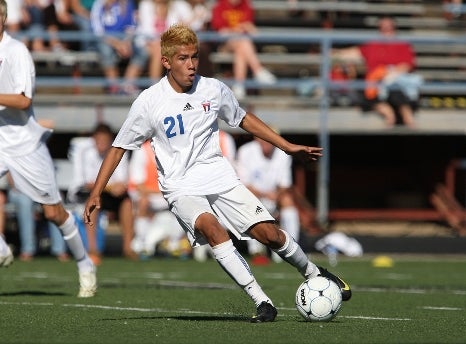
Cherry Creek standout Miguel Jaime chose to play for the Bruins this season instead of training with a development academy. Several top players bypassed their high school teams this fall, which is a growing trend.
File photo by Patrick Miller
It was not a decision
Miguel Jaime took lightly.
The junior from
Cherry Creek (Greenwood Village) was well aware of the stakes. Joining the Bruins boys soccer team was completely at odds with the directives set forth earlier this year by U.S. Soccer in regards to the expectations of the athletes training with any of the organization's Development Academy programs.
Jaime, an academy player with the Littleton-based Colorado Rush, weighed his options. In February, U.S. Soccer made its announcement stating that it was moving to a 10-month schedule for development academies, all but forbidding its athletes from competing in high school sports.
This never sat well with Jaime. Despite knowing it might put his stature with the Rush at risk, Jaime just could not imagine spending his fall without donning his Bruins jersey.
Jaime is one of few examples this fall among the state's best soccer players opting to remain with his school team instead of focusing his efforts on a development academy.
"I love to represent my school," said Jaime, who will rejoin the Rush after the high school season. "I love seeing my friends in the halls and telling them to go to tonight's game. It's such a social environment.
"They (the Rush) didn't argue with me. They gave me the choice. They said to follow my heart and do what was best for me. High school is what I wanted to do."
Although the move to a 10-month development academy schedule has affected high school programs across the country, Colorado offers a unique perspective, given that it is home to three of the nation's 80 development academies.
Such clusters typically are seen strictly in population metropolises like Dallas, Chicago, Southern California and the big cities of the East Coast. And that, essentially, is the rub among high school coaches in Colorado.
Given the U-16 and U-18 levels, typically the high school-aged athletes, draw roughly 100-120 players away from their respective high schools to the three academies (the Rush, Real Colorad, and the Colorado Rapids Academy), coaches are questioning whether that many soccer players truly benefit from the academy experience, as opposed to playing for their high schools.
"The only place the best of the best should go is the Rapids because they have the backing to do it," Cherry Creek coach Chelo Curi said. "They're forcing 14- and 15-year-old kids to make a life decision they're not capable of making yet."
Curi gets emotional discussing the notion that elite players cannot possibly receive the same level of training at their high school than they would with a development academy, stating, "I'll put my resume up against anyone in Colorado."
In this case, both sides have a point. No doubt, the coaching resumes seen at the big-school level in Colorado have grown steadily more impressive, and even former University of Colorado coach Bill Hempen is now the leader at Class 3A
Alexander Dawson (Lafayette).
Yet when academy coaches pressure athletes about the exposure they receive through academy showcases — indeed, college recruiters rarely make their observations at high school games anymore — the fear of not eventually landing a scholarship becomes almost unbearable.
"It was inevitable and a lot of us saw this coming, but it's still very disappointing,"
Fort Collins coach Justin Stephens said. "There are major high school programs with high quality coaching. For academies to do this, well, it maybe made sense 10 years ago, but not now. I think they lose a lot when they don't get to put on those school colors."
Few of the state's top high school programs have escaped unscathed. Stephens' Lambkins are playing without Sam Tweeton, who contributed three goals and four assists in 2011, and freshman Eric Chang, who would have been the heir apparent in goal.
Cherry Creek is without five expected contributors, including 11-goal scorer Marcos Toscano. Perennially competitive programs at Fairview (Boulder), Boulder and Broomfield were affected by development academy defections, while defending Class 5A state champion
Denver East is playing without 2011 leading goal-scorer Ashi Geberkidane.
Oddly, this first season of the new reality comes on the heels of Shane O'Neill's widely applauded debut with the Rapids. The former standout at Fairview declined an invitation to join the Rapids Reserves, which would have ended his high school eligibility, in order to complete his decorated four-year career with the Knights.
In June, shortly after graduation, O'Neill passed up a scholarship from the University of Virginia in order to sign with the Rapids and make the jump from high school to the pros.
In the new reality, there probably will be fewer Miguel Jaimes. And perhaps no Shane O'Neills at all ever again.
"It's great to watch a guy like Shane O'Neill sign with the Rapids after he opted to play for his high school," Stephens said. "Some of these guys, in reality, they're traveling an hour and 45 minutes each way to train for two hours. You get home at 9 and you don't know anything else. There definitely is an aspect where he's not as involved in the other parts of high school."
